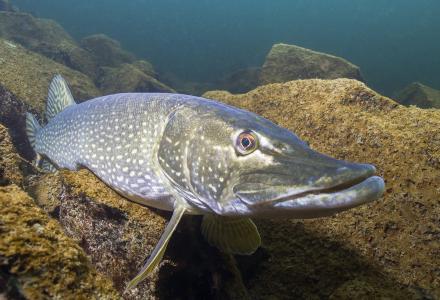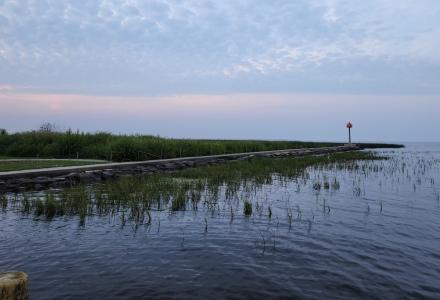
Map of the different jurisdictions and nations of the Rainy-Lake of the Woods basin included in the third State of the Basin report. Credit: Grand Council Treaty #3
The third State of the Basin report for the Rainy-Lake of the Woods region provides an overview of the most pressing issues facing those waterways, such as nutrient pollution, algal blooms and climate change. It’s also the first time for these series of reports that Indigenous Ecological Knowledge has been a major focus alongside Western science.
The report was unveiled at the March 2022 Rainy-Lake of the Woods Watershed Forum. The report was drafted and edited by two authors: Bev Clark, focusing on Western scientific approaches, and Lucas King, focusing on Indigenous Ecological Knowledge.
Representatives from local government agencies, Minnesota, Ontario, Manitoba, the federal governments and Indigenous nations all played a role in its development, reviewing the data and what was drafted from both perspectives.
Experts from Grand Council Treaty #3 and the International Multiagency Arrangement, which consists of local and agency personnel from both sides of the border, were truly integral to the report’s creation, said Todd Sellers, president of the Lake of the Woods Sustainability Foundation and member of the IJC’s International Rainy-Lake of the Woods Watershed Board. “I think it will provide a holistic view of the state of the basin to reflect Indigenous knowledge systems and perspectives on the state of aquatic ecosystems and resources,” Sellers said. “That’s the big difference between this one and (the 2014 report).”
Lucas King, Territorial Planning Unit director for Grand Council Treaty #3, added, “The State of the Basin report is an important step to deepening the collaboration between Indigenous and Western knowledge systems across the basin.
“The complex multi-jurisdictional nature of the basin provides its own unique set of challenges. However, how we work together, learn and respect each other’s knowledge and systems to tackle those challenges is fundamental in respecting and furthering relationships as Treaty partners, while supporting our relationship and responsibilities to Nibi (Water) as outlined in the Treaty #3 Nibi Declaration.”
A lot has been learned since the 2014 report thanks to separate studies conducted by the Minnesota Pollution Control Agency and Environment and Climate Change Canada, Sellers said.
The report found that nutrient pollution and algal blooms in Lake of the Woods remain one of the biggest issues in the basin. At the time of the report’s publication, Minnesota had finalized loading targets for nutrient pollution into the lake, with Canada still in process of finalizing its own. Once that work is complete, Sellers said he hopes a binational effort to reduce new nutrients getting into the system will improve the algal bloom problem.
There is no evidence that the level or concentrations of nutrients in Lake of the Woods has shifted since the previous report was completed in 2014, Sellers said. Due to the size of Lake of the Woods, concentrations vary based on the time of year and location in the lake, with the southern end of the lake often having the highest concentrations over the summer into late fall.


A photo from the report, showing algae on Lake of the Woods. Credit. Nancy Dunnel
Beyond the nutrient issue, the report finds very few other contaminants—such as such as heavy metals, chemicals and arsenic—exceeding existing objectives and alert levels within the basin. Most exceedances were detected from Rainy River. There also are concerns in the headwaters region of the basin about proposed mines and any long-term water quality issues that could emerge from those.
Invasive species continue to be a major concern, Sellers said, particularly zebra mussels.
Larval zebra mussels have been detected in Black Bay of Rainy Lake, and while no adult colonies have been found so far, he said it’s likely they’re lurking in there somewhere. Zebra mussel larvae had previously been found in southern Lake of the Woods, and the similarly invasive spiny waterflea has been detected for years in the region.
The Rainy-Lake of the Woods Watershed Board backed a risk assessment of aquatic invasive species to determine the biggest threats to the basin based on ease of transport and risk of establishment. Spiny waterflea, rusty crayfish, round goby and zebra mussels all appear on the list.
In 2018, the watershed board instituted “sturgeon protocols” for managing flows through the basin during spawning season; the hope is that this will help strengthen the sturgeon population over time. Similarly, the board and Indigenous partners are designing a study to develop a similar protocol for manoomin, or wild rice, which would help that culturally and culinarily important plant survive to harvest along the shores of the water system.
Climate change remains a large concern for the region, Sellers said. Based on existing studies, the warming climate would likely bring more extreme weather events and warmer water temperatures to the region, which would result in more habitat to unwanted invasive species and a lengthier algal bloom season.
“Leaning on Lake of the Woods data and long-term datasets nearby at the Experimental Lakes Area, they’re showing that a longer ice-free growing season continues in the basin, with an average increase of the ice-free season of about three-to-four days a decade,” Sellers said.
The report includes a series of identified knowledge gaps and recommendations, including harmonizing invasive species prevention efforts, developing a multi-jurisdictional watershed planning framework, engaging Indigenous nations to ensure each is involved in the extent and manner it would like, developing a watershed mining activities map and developing tools to address drought conditions.
Both the full report and an overview can be found on the Lake of the Woods Sustainability Foundation website and the IJC's website. Work on the report started in 2021 with the assistance of the IJC’s International Watersheds Initiative.

Kevin Bunch is a writer-communications specialist at the IJC’s US Section office in Washington, D.C.



